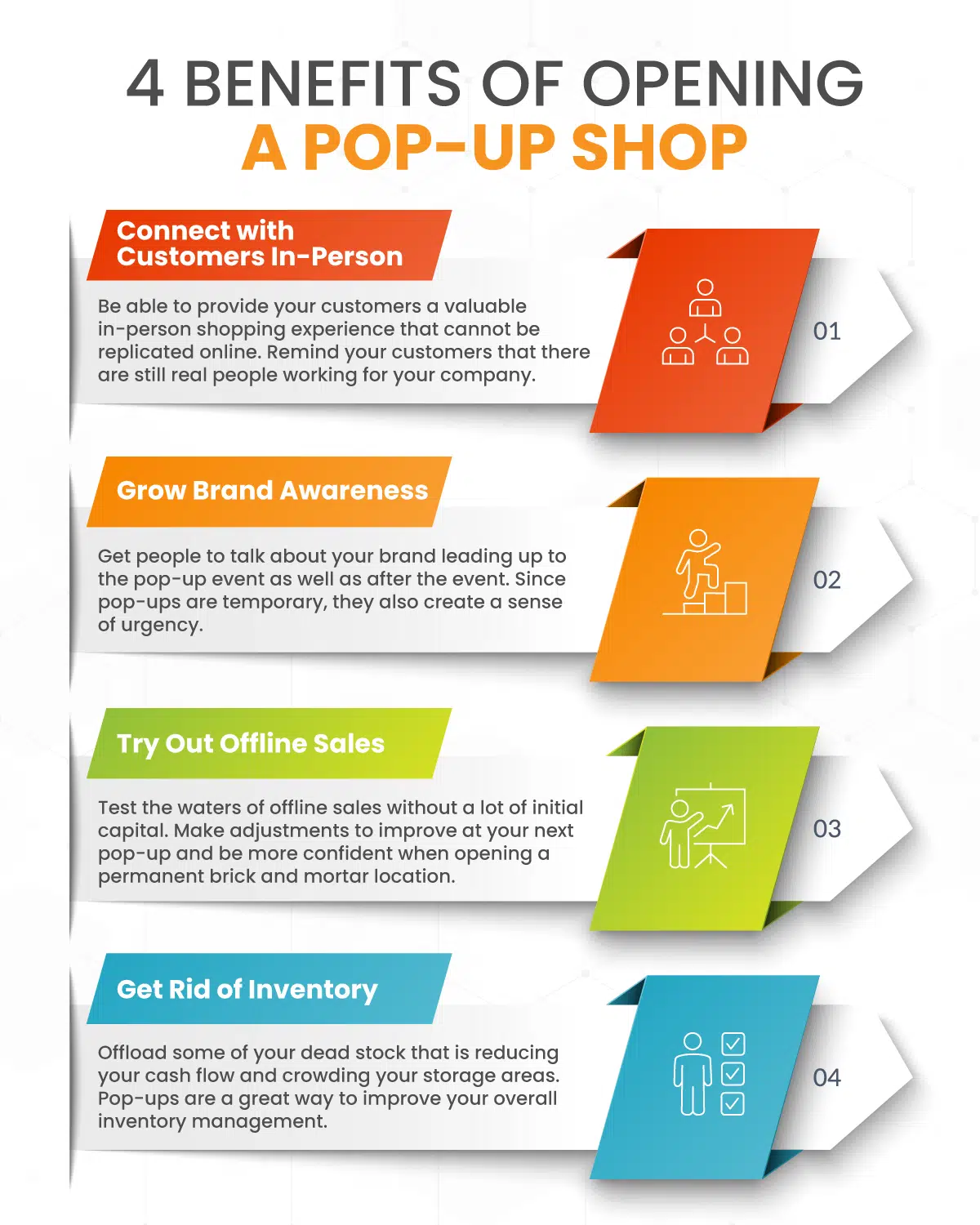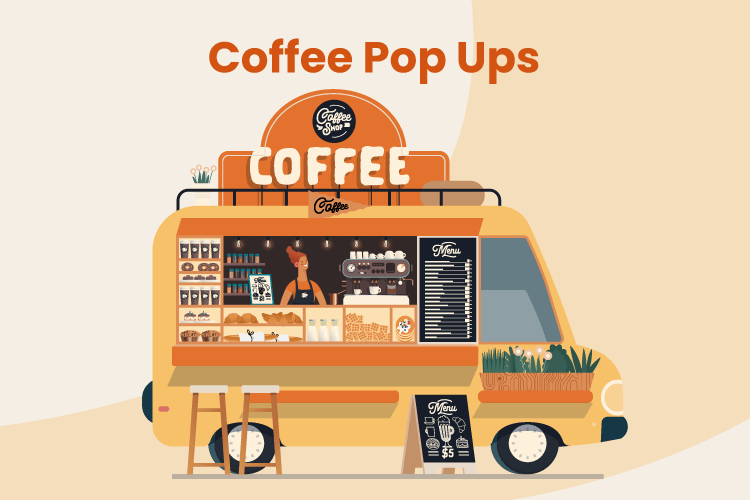Pop-up shops are happening all over the country, and they’re spanning various niches. Food trucks, apparel stores, designer jewelry, and coffee shops are showing up everywhere you look.
Pop-ups are a great way of bolstering brand awareness and creating some buzz around your store. In expensive urban areas, they’re also a more affordable way of running a business. And for eCommerce retailers, pop-ups are a safe way to test a trial run of a brick and mortar shop.
But just because they’re small doesn’t mean that it’s easy to open a pop-up shop. So check out these tips on how to start a pop-up coffee shop. And some of these tips will apply to coffee kiosks or full-service stores, too!

What Is a Pop-Up Shop?
Pop-up shops are temporary stores that can also be mobile. They are typically small in size, but have the same look and feel of a traditional brick and mortar store.
Pop-ups are most popular among small, online retailers who might use the store to grow brand awareness or to test the waters for expansion into the brick and mortar side of retail.
This new wave of stores often uses the unique opportunity to create a unique shopping experience. Customers are already surprised by the very nature of the pop-up, so retailers take it a step further to make it even more memorable. For some digitally-native brands, for instance, this could involve some more hands-on interaction with the products that shoppers wouldn’t be able to participate in otherwise.
Costs of opening a pop-up vary, but in general, it’s an affordable way to make a splash and encourage more growth in your business.
What Are the Benefits of Opening a Pop-Up Shop?
There are a lot of different reasons that a business owner might want to open a pop-up store. Below are a handful of the most common:
Connect with Customers In-Person: A big divide between eCommerce and brick and mortar is that shoppers aren’t able to physically interact with the product. There are various types of technology eCommerce stores can implement to help bridge the gap, but so far it can’t entirely replicate the in-person shopping experience. A pop-up is a great way to remind your customers that there are still real people working for your company.
Grow Brand Awareness: Creating a buzz around a brand or product will help put you on the radar of more shoppers. A temporary pop-up is a great way to get people to discuss your brand. Since pop-ups are temporary, they also create a sense of urgency. Therefore, it’s also wise to advertise the closing date of the pop-up, too.
Try Out Offline Sales: For eCommerce merchants, pop-ups are a great way to start testing the waters of offline sales at a brick and mortar shop. Pop-ups don’t need a lot of initial capital to get started. So if things don’t go quite as planned, it’s not a big deal. You can adjust and try it again with another pop-up. This lets retailers feel more confident when they finally decide to open a full brick and mortar location.
Get Rid of Inventory: Moving through overstocked inventory is critical. Holding too much in your warehouse means reduced cash flow and crowded storage areas. It’s surprising how costly dead stock can be to any business. So use a pop-up as a way to offload some of this and improve your overall inventory management.
What’s a Good Checklist on How to Open a Pop-Up Shop?
Get your store prepared for a pop-up by going through this checklist. A pop-up is meant to be exciting and fun, but it’s also imperative that put in the work first.
1. Ask the Right Questions
Most shops will mean you’re renting the space or equipment. You need to make sure that everything runs smoothly, so it’s important to get started with the right questions about how to open a pop-up shop.
- What are the fees? Shop around and find a spot that gives you the best options.
- Are there extra utility fees? Find out if there are any hidden costs or extra fees that might surprise you at the end. Make sure everything is in the contract.
- What are the dimensions of the space? Pop-ups are usually quite small, so getting the exact dimensions is necessary. You need to make sure you plan correctly for the space.
- Can you make any changes to the space? Many retailers opening a pop-up shop will want to put their personal touch on the space. If you’re one of them, check to see if this is allowed.
- Where does liability lie? Find out what you’re responsible for and what the property owner is on the hook for. It’s better to iron out any details early on that may lead to legal disputes down the road.
- What foot traffic do they anticipate getting? Make sure that your traffic is relevant to what you’re selling.
2. Chose Products and Prices
You want your pop-up to stand out, so when you’re preparing the products that you’ll offer, choose items that will stand out and grab attention.
Many businesses use a pop-up to help promote a new product or service that they offer. It’s a great way to get people talking about it, and allow consumers to try the product in a fun way and at a reasonable cost.
In other cases, it might be best to focus on seasonal items. Get products that you need to move quickly during the holiday season or summer months.
Make your prices reasonable and use this as an opportunity to market and let your customers try out a few things. Pop-ups usually aren’t big money makers off the bat. Instead, they will make businesses money down the road by attracting more loyal shoppers.
3. Find a Great Location
Finding the right location for a pop-up is not the same process as it is for a long-term brick and mortar spot.
- Look for open retail space. An empty store will make the logistics of setting up a pop-up much easier. With the infrastructure in place, all you’ll need to do is add your branding and decoration.
- Find space for a kiosk or stand at a mall. This is an area guaranteed to have foot traffic and lots of shoppers, so it’s a perfect spot to set up and introduce yourself to passersby.
- Ask established retailers if they would be open to hosting a pop-in. These are pop-ups inside of another store. Look for retailers who have similar goals or ethics and team up with them.
- Set up at a local event, like a fair, music festival, or city event. Like malls or shopping centers, these areas have a plethora of foot traffic so you’ll have no shortage of potential new customers.
- Get a van or truck and make your pop-up mobile. More and more pop-ups are investing in mobile stores so that they can show up at or near major events or popular night spots. Opening a food truck across the street from several bars is ideal for a Friday or Saturday night but not so much during weekdays. This gives you freedom and flexibility.
4. Get the Right Equipment
Start early with your equipment planning. It’s important to have all rentals and purchases figured out for your pop-up.
- Make sure that you have all branded equipment and signage organized and ready to go.
- Figure out what display equipment you’ll need, like shelving and racks.
- Get all mPOS equipment so that you can accept payments at the pop-up.
- If you’re selling food and drink, figure out your refrigeration system early on.
- Get wifi set up if you’re going to add that the store experience.
5. File All Paperwork and Get Permits
Like any business, pop-ups come with rules and regulations that must be followed if you want your business to succeed.
- Most pop-ups will sign a lease on the space. Make sure you know what you’re signing and get the right terms of the lease.
- For really short term pop-ups, like at a concert or state fair, you’ll more likely just need to get proper licensure. The process and conditions will be similar to a lease, however.
- Figure out if you’ll need any special permits. If your store sells food or drink, for instance, you will need to apply with the local health department.
- Get insured to mitigate risk. Protect your business from something catastrophic with basic business insurance or commercial insurance.
6. Promote It
Pop-ups are exciting, and easy to get people talking about them. Consumers want a unique experience and the luxury of being one of the first to try a certain product.
- Send out invites on social media. Instagram is one of many great platforms to advertise a pop-up and get people excited about it.
- Do your research on local influencers and find a few that would be interested in participating. You don’t always need to find the biggest influencers; instead the focus should be on relevancy and how many additional shoppers they’ll bring into your store.
- Write a brief press release to make the pop-up opening more official and exciting.
- Request RSVPs to add a level of exclusivity. This will also allow you to send reminders to keep up with people who are interested in attending.
7. Measure the Success of Your Pop-Up Shop
At its heart, a pop-up shop is a marketing outlet. It’s meant to increase awareness of your brand and bring more customers in your doors.
And like any marketing endeavor, it’s important to know if it’s worth the time and money. After all, many retailers will lose money on a pop-up. But that’s fine, as long as it’s worth it in the long run.
Check out your sales metrics in your point of sale system. You can organize your sales and inventory by many different categories, giving you more insight into your pop-up shop’s performance.
You can also look at other KPIs to help gauge your pop-up success. One easy way is to analyze foot traffic before and after the pop-up shop.
A more rudimentary, but nonetheless effective way to determine success is by simply asking around. Get feedback and show that you care by asking customers about their experience and encouraging more engagement.
For more retail advice, subscribe to our blog. And if you need a POS system that can work for your eCommerce store, traditional brick and mortar shop, or pop-up location, KORONA POS will help your store succeed. Try it out for free by clicking below and signing up.












